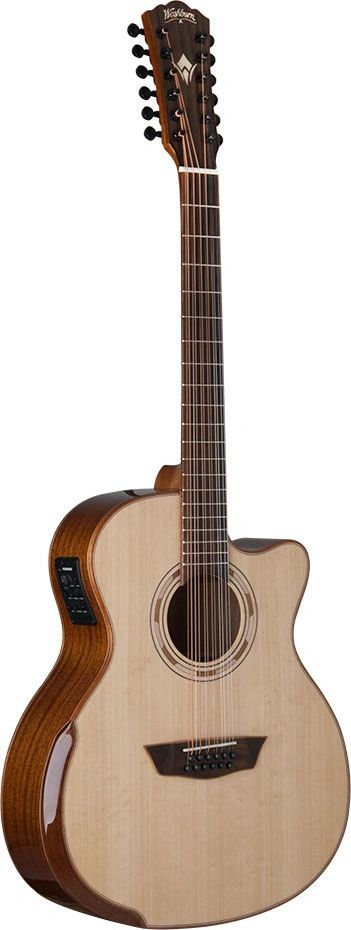
Finding the easiest acoustic guitars to play isn’t just for beginners; it’s for anyone who wants a more comfortable and satisfying experience. Playing should be a challenge but still a joy, and it should be designed with features and touches that make it easier to play right out of the box.
There are several factors that go into the comfort and performance of an acoustic guitar without compromising on quality. We’ll explore some of the easiest acoustic guitars to play, from neck profile to high vs. low action, to find the right choice for you.
What Makes a Guitar Easy to Play?
A major part of what makes a guitar easy to play is its action. The action is the distance between the strings of your guitar and the fretboard. When a guitar has a lower action, it’s usually easier to play because the strings are closer to the frets and require less force when pressing down the strings.
Action
When the action on your guitar is too high, the strings are farther away from the fretboard, requiring more force to press on the strings and produce the right notes. Several things impact high action, including its design, heavy-gauge strings, a warped guitar neck, or a poorly cut nut that creates issues when playing.
Low action on a guitar doesn’t require as much force to press down on the strings. Most players find lower action easier to play, especially over extended playing sessions. There are some exceptions; when the action on a guitar is too low, it results in fret buzz or string rattle, which negatively impacts the sound and playability of the guitar.
Neck Profile
Neck profile can impact how easy or difficult a guitar is to play, but it also depends on the size of your hand and your personal preference. A thin neck profile is usually easier to play when you have smaller hands, arthritis, or a hand injury and can’t press down on the strings as hard. Thin neck profiles usually accommodate fast-playing styles and more complex songs.
When it comes to neck profiles, C-shape necks are thinner and a common go-to choice for players looking for the easiest acoustic guitars to play. Flat neck profiles also reduce the amount of movement you need to press the strings and frets for faster and more fluid playability. However, just because a guitar neck is thick doesn’t mean it’s always challenging to play. You probably want a thicker neck profile if you have large hands or prefer a substantial grip.
String Placement
String placement, or its spacing and alignment, also impacts the guitar’s ease of playing. When strings are placed too close together, playing individual strings without accidentally mashing multiple strings is challenging. When they’re too far apart, managing chords or reaching certain frets is challenging.
Some guitar brands, like Zager Guitars, make slight changes to their string placement so they’re not too close together but enough to make the strings easier to press chords or perform specific techniques. They also carbon-coat their strings for pillow-touch playing. Overall, the string placement of any guitar should feel comfortable and natural, allowing for accurate playing and minimal discomfort. It’s essential to consider the string spacing when selecting a guitar, as it can impact how easy or difficult it is to play.
String Gauge
String gauge, or the thickness of the guitar strings, impacts a guitar’s ease of playing. You’ll need to apply more pressure to get the sound you want when the string gauge is thicker, stronger, and has more tension. A heavy gauge string usually isn’t a good fit for beginners or anyone with small hands or arthritis. Comparatively, lighter strings require less finger strength, but they tend to produce brighter sounds that seem light compared to the warmer, full sounds of strings with heavier gauges.
Body Shape
A guitar’s body shape impacts how comfortable it is to play and for how long. Some guitar models with deeper cutaways, such as Stratocasters or Les Pauls, are designed to fit snugly against your body to improve playability and access to the upper frets while playing. But the shape of a guitar is mainly about personal preference, and not everyone will find the same guitar shape comfortable to play.
Body Size

The size of your guitar also matters, but smaller isn’t always better. It depends on your personal preferences and the type of music you’re playing. Here’s a breakdown of different body sizes and what to expect from each.
- Parlor – Parlor guitars are small and compact, usually sit lower on your knee, and are easier to manage while playing. They’re especially popular among players of a smaller stature.
- Concert – Concert guitars are slightly larger than parlors and have shallow bodies. The shoulders of the guitar are smaller than its middle, making the waist of the guitar look more prominent.
- Auditorium – Auditorium guitars are thinner than parlor and concert guitars with medium-sized frames. They’re also smaller and curvier than a dreadnought.
- Dreadnought – Dreadnought guitars are constructed to look large and bulky, popular among tall players.
- Jumbo – As the name implies, jumbo guitars are the largest guitar size to choose from and aren’t usually a good fit if you’re on the small or petite side.
Just because a guitar may sound good for someone tall or short doesn’t mean you can’t stray from the norm. Plenty of smaller players enjoy dreadnought guitars, and someone of larger stature can still reach for a parlor guitar.
Guitar Quality
Guitar quality matters when it comes to acoustic guitars and how easy they are to play, but only to a point. Higher-quality guitars have more focused craftsmanship, better tonewoods, and a more resonant and clear sound.
Let’s take the neck construction as an example. If you buy an acoustic guitar with quality construction, the neck should align with the body while the tonewoods hold a consistent sound. Cheaper guitars are often made with a blend of synthetic woods and may come with cheaper necks that are misaligned and lead to poor playability.
You can still get a reasonable sound out of some cheap guitars, which may work well for your needs as a beginner or hobbyist. A sweet spot would be in the $800 to $2,000 range to get a good quality guitar that doesn’t break the bank. Once you soar past $3,000, you’re likely paying for a premium brand name instead of the guitar itself.
Do You Need an Easy Play Guitar?
Whether or not you need an easy play guitar depends on your goals and comfort level. If you have small hands, arthritis, a hand injury, or have never been able to adapt to playing the guitar, you should try an easy play option. An acoustic guitar with easy playability is worth the investment, whether looking for a slimmer neck, low action, or meticulous string placement.
There’s something else to consider. The easiest acoustic guitars to play don’t necessarily make learning the guitar easy. They simply help with comfort level, reducing fatigue and making some issues with learning an instrument easier, like accessing the higher frets. If all those issues impact your ability to learn, then yes, an easy guitar will probably help. But if you’re looking for shortcuts to learning the guitar, even the easiest acoustic guitars on the market will only help with a few hurdles, leaving the rest up to you and your commitment to practice.
How Much Should You Pay for an Acoustic Guitar?
A beginner, no-nonsense acoustic guitar ranges from under $200 to $400. It will work fine if you’re primarily focused on learning and aren’t too concerned with comfort or consistent sound. A solid guitar ranges from $500 to $1,500; however, custom-made guitars with the backing of big brand names fetch $3,000 to $10,000.
There are a few exceptions. Fender and Gibson Guitars have their own budget brands with decent guitars that hold their sound, although they don’t scale to professional levels. Or a company like Zager Guitars sells direct to consumers and eliminates retail markups altogether.
Which are the Easiest Acoustic Guitars to Play?
Once you know what to look for in an easy play guitar, here are a few options to choose from.
Washburn G15SCE-12

As part of the Washburn Comfort Deluxe Series, the Washburn G15SCE-12 features an Ergonomic Armrest Bevel and Grand Auditorium cutaway body for more comfort. With superb playability and response, the mahogany neck and ovangkol fingerboard make this guitar ideal for fingerpicking across your chords. A solid Sitka spruce top mahogany back and sides hold a resonant sound while players enjoy the unique belly and curves that hug the body instead of digging into it whether you’re standing or sitting.
The Washburn G15SCE-12 retails for $949.
Zager Guitar Easy Play ZAD900
Zager Guitars’ Easy Play ZAD900 Series stays true to its name with a low string height, comfortable neck, and gorgeous craftsmanship for easy playability. With a dreadnought style and solid wood construction, this Zager Guitar features hand-carved bracing for greater movement and a rich sound. A soft touch fret design keeps the finger fatigue at bay with less string bite and an adjustable truss rod to raise or lower the action, depending on your favorite playing style.
The Easy Play ZAD900 retails for $1,995.
Fender Acoustasonic Telecaster
Fender’s Acoustasonic Telecaster blends the sensibilities of an acoustic body with the electronics you want from an acoustic-electric guitar. It’s known for its comfortable playability, light, and ease of holding. A hollow body creates a loud and resonant sound and projection so you can sustain a powerful sound on your lap or onstage. It’s designed for a hum-free experience and has a thin mahogany neck with an ebony fingerboard to add warmth to your next song.
Although more of a hybrid guitar, the Acoustastonic is outfitted with acoustic strings to deliver a more authentic sound. You also get some of the perks and functionality of playing an electric guitar.
Fender’s Acoustasonic Telecaster retails for $2,000.
Taylor 814ce
The Taylor 814ce is among the brand’s more popular acoustic guitars. It blends refined craftsmanship, quality tonewoods, and a textured sound. With a Grand Auditorium style, you’ll find this Taylor Guitar both comfortable and rewarding to play. You’ll also hear the difference in the East Indian rosewood back and sides, a Sitka spruce top, and slightly scooped midrange. A Venetian cutaway and rosewood armrest offer more comfort while playing to prevent fatigue after an extended jam session or performance.
The Taylor 814ce retails for $3,999.
Epiphone Les Paul Special II
If you’re looking for an inexpensive acoustic guitar that holds a decent sound, the Les Paul Special-II E1 is ideal for beginners looking to get comfortable with the feel and tone of higher-end brands. It features a mahogany body, comfortable neck, and a rich, warm sound. It’s also lightweight and has decent built-in electronics, but it won’t scale for more serious players.
The Epiphone Les Paul Special II retails for $219.
Martin DJR-10e
The Martin DJR-10e provides a full, booming sound with great playability. It looks sleek and stylish without compromising on the quality you would expect from a Martin Guitar. It’s also smaller than a regular dreadnought, making it more comfortable for smaller players. A thinner body and high-performance neck taper make it easy to play during a long gig or when you want to refine your craft with long practices.
The Martin DJR-10e retails for $699.
Gibson Montana Hummingbird
The Gibson Montana Hummingbird is regarded as a high-end, easy-to-play acoustic guitar that blends vintage style with modern quality construction. It’s outfitted with gold tuners, antique binding, and a traditional truss rod cover. A unique bone nut and saddle dress up this look in an Antique Natural or Heritage Cherry Sunburst finish. It plays easily with good action but won’t sound like the vintage guitars of the 60s that inspired its look.
The Gibson Montana Hummingbird retails for $3,999.
Seagull S6 Original
With great action and playability, the Seagull S6 Original features excellent construction and a bright and vibrant sound. It’s also outfitted with a quality saddle and nut for an improved tone. Handcrafted in Canada, the Seagull S6 is constructed with Canadian Wild Cherry and a pressure-tested solid cedar top to create a resonant sound. A tapered headstock and thick neck may trouble players with smaller hands but scales well for larger hands or anyone who wants a more substantial grip.
The Seagull S6 Original retails for $779.
Next Steps
Finding the easiest acoustic guitar to play is more than selecting just the right neck profile and string action; but is a personal preference for how comfortable the instrument feels in your hands. For us, we’re Zager Guitar fans for their ease and comfort of playing at a reasonable price point. They’re also handcrafted and come with unique touches like carbon-coated, pillow-touch strings.
Before you make your next acoustic guitar purchase, make a list of the most important factors to you and look for a brand with a reputation for quality, good return policy, and a focus on making the playing experience as comfortable as possible, whether you’re a beginner or a pro.
